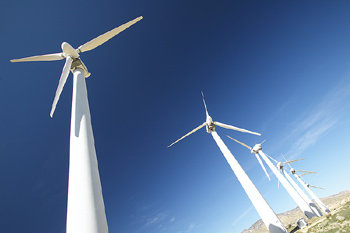Secrets behind Wind Turbine Technology

In some places of the world, wind turbine power accounts for ten percent of the total electricity consumed. This is, sadly, a very small fraction of the power generation and consumption coming from coal plants as well as from solar panels. Still, it is progress that we should welcome for the simple reason that taking it one step at a time is better than taking no steps at all in the right direction.
To take these small but important steps towards cleaner electricity through wind power, it is important to know about the secrets, open these may be to anyone interested, behind wind turbine technology.
Turbines in Relation to the Generation of Electricity
Think of your ordinary electric fan – it generates wind by using electricity. Now think of the wind turbine although in a reverse mode – it generates electricity by using wind. The technology behind wind power can be summed up as simply as that statement.
But of course, electricity generation is hardly ever that simple. Let’s put it this way for the non-techie amongst us. The turbine blades are designed so as to capture the maximum amount of wind, which will cause them to rotate. In turn, the rotation spins the low-speed shaft gear connected to the high-speed shaft gear, the latter of which is housed inside the generator housing.
The domino effect is such that the electrical current generated by the movement of the gears, shafts and rotors are then fed into the main grid or a battery pack. You will then enjoy the benefits of electricity.
Residential Wind Turbines
Lest you think that you cannot have a wind turbine in your home, think again. Although you should ask local authorities and consider environmental conditions in your area, you can avail of residential wind turbines starting at around $12,000 each.
If you think that it is too much money, do consider that energy tax rebates are available that can lessen the final cost of the unit. Plus, you can recoup your investment through lesser dependence on the main grid, not to mention that your carbon footprint on our already beleaguered planet is also significantly lesser.
Just to give numbers to this eco-friendly fact, for every kilowatt-hour of wind turbine-generated electricity consumed, about 1.5 pounds of carbon emitted into the air by coal-powered plants can be avoided. You do know that carbon dioxide is one of the major contributors to global warming, don’t you?
Passing of Wind Considerations
We are talking about placing your residential wind turbines in an area where the maximum amount of wind can be experienced. An average residential turbine requires wind speeds of 10 miles per hour to generate electricity. So, if you live in an area with little to no wind, you should opt for solar panels. But if you are really enthusiastic about wind power, you should look into turbines that can operate on 5 miles per hour wind speeds. And with blades as large as 20 meters, you must make sure that the neighbors will not be disturbed by the rotations.
As with any other methods of power generation, wind turbines have their merits and demerits. Still, when it comes to clean energy from wind power, we are willing to take the cons with the pros anytime of day.



